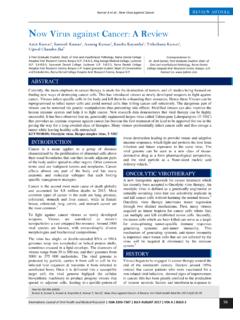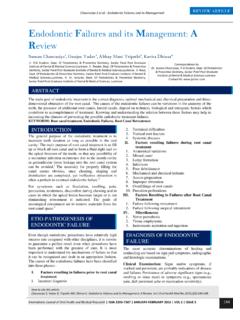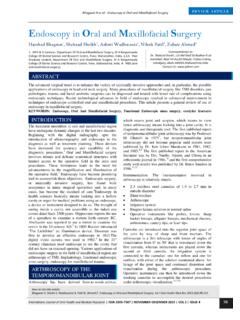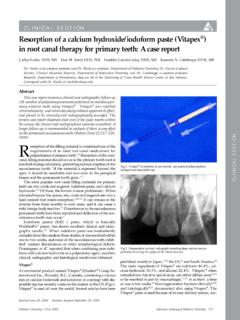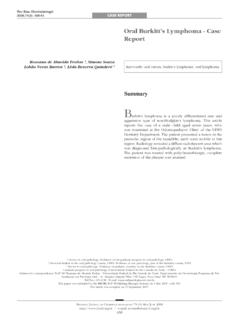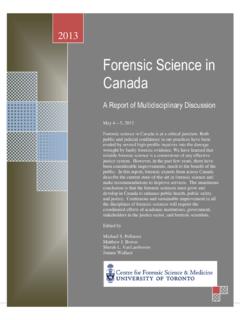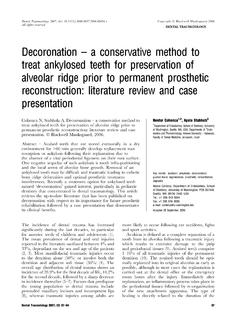Transcription of Taurodontism in Pediatric Population: A Review - …
1 International Journal of Oral Health and Medical Research | ISSN 2395-7387 | MARCH-APRIL 2016 | VOL 2 | ISSUE 6 145 Review ARTICLE Jadhav G et al.: Taurodontism in Pediatric population Correspondence to: Dr. Geetanjali Jadhav, Post Graduate student, Dept of Pediatric Dentistry, Bharati Vidyapeeth Dental College and Hospital, Pune. Contact Us: Taurodontism in Pediatric population : A Review Geetanjali Jadhav1, Rahul Lodaya2, Amit Chavan3, Nimish Salunkhe4 Taurodontism is a rare dental anomaly in which the affected tooth has an enlarged and elongated body and pulp chamber with apical displacement of the pulpal floor. It has a very low incidence, and very fewer cases are reported in the literature in deciduous dentition. Treatment of a taurodont tooth is challenging and requires special handling because of the proximity and apical displacement of the roots.
2 KEYWORDS: Taurodontism , Anomaly, Developmental DisturbanceAA aaaasasa sss Taurodontism is a developmental disturbance of a tooth that lacks cervical constriction at the level of the cementoenamel junction (CEJ). It is distinguish by vertically elongated pulp chamber, apical displacement of the pulpal floor and bifurcation or trifurcations of the roots (Jafarzadeh et al. 2008.). History: Taurodontism was first described in 1908 by Gorjanovic-Kramberger1 a 70,000-year old pre-Neandert-hal fossil, discovered in Katrina, The term Taurodontism was however first specified by Sir Arthur Keith in 1913. The origin of this term is from Greek Taurus which means Bull and odontoid which means Tooth .3 The literature contains reports of Taurodontism with high frequency in Eskimos probably an adaptation from cutting Shaw5 reported the incidence to be as high as 30% in hybrids of Australoids and the Bush people of South Africa.
3 Taurodontism has been found in mongoloid and negroid It seems Taurodontism is a great deal more frequent than it was previously thought Seow and Lai found that of 66 patients with hypodontia had at least one mandibular first permanent molar that showed Taurodontism compared with only of a control group without Theories regarding the causes of Taurodontism have been many. It has been suggested that the abnormality represents a primitive pattern, a mutation, a specialized or retrograde character, an atavistic feature, an X-linked trait, familial or an autosomal dominant trait. Although Taurodontism has been reported in relation with certain syndromes and some genetic defects, its true significance is still Taurodontism may be an isolated condition, but it has also been associated with various developmental syndromes and anomalies including amelogenesis imperfecta, Down s syndrome, ectodermal dysplasia, Klinefelter syndrome, trio-into-osseous syndrome, Mohr syndrome, Wolf- Hirschhorn syndrome and Lowe Taurodontism has also been reported to present with other rare syndromes such as Smith- Magenis syndrome, Williams syndrome, McCune-Albright syndrome and Van der Woude syndrome.
4 Theories concerning the pathogenesis of Taurodontism root formation are also diverse: an unusual developmental pattern, a delay in the calcification of pulpal chamber, an odontoblastic deficiency, an alteration in Hertwig s epithelial root sheath. According to some authors, Taurodontism is most probably the result of disrupted developmental In 1928 Shaw5classified this condition as hypo Taurodontism , meso Taurodontism and hyper Taurodontism based on the relative displacement of the floor of the pulp Chamber (figure ). How to cite this article: Jadhav G, Lodaya R, Chavan A, Salunkhe N.
5 Taurodontism in Pediatric population : A Review . Int J Oral Health Med Res 2016;2(6):145-147. INTRODUCTION 1,3,4-Post Graduate student, Dept of Pediatric Dentistry, Bharati Vidyapeeth Dental College and Hospital, Pune. 2-Associate Professor, Dept of Pediatric Dentistry, Bharati Vidyapeeth Dental College and Hospital, Pune. ABSTRACT ETIOLOGY AND PATHOGENESIS CLASSIFICATION Figure no. 1 Types of Teeth. International Journal of Oral Health and Medical Research | ISSN 2395-7387 | MARCH-APRIL 2016 | VOL 2 | ISSUE 6 146 Review ARTICLE Jadhav G et al.: Taurodontism in Pediatric population This subjective, random classification led normal teeth to be misdiagnosed as Taurodontism . In 1977, Leechfnger and Rosewall stated that the distance from the bifurcation or trifurcation of the root to the cementoenamel junction should be greater than the occlusocervical distance for a Taurodontism tooth (figure ).
6 Though there are many classification systems to determine the severeness of Taurodontism , Shifman and Channel in 1978 proposed a new classification and is the widely used system till now. Taurodontism index: vertical height of the pulp chamber distance between the lowest point of the roof of the pulp chamber to the apex of the longest root and the distance between the baseline connecting the two cemento-enamel junctions and the highest point on the floor of the pulp chamber. Establishment of a condition of Taurodontism is made when1/2 multiplied by 100 is above 20, and 3 exceeds mm: (1/2)* 100 > 20 and 3 > mm. Taurodontism index (TI) = 1/2 100. In this case TI= 61 and 3= 8 mm, clearly indicating hyper Taurodontism Review of the literature reveals a wide discrepancy in the prevalence of Taurodontism in different populations.
7 The prevalence of Taurodontism in children was found to be Identification of the condition can only be done by radiographic examination as the external morphology of the teeth is within normal configurations. The radiographic examination is the only way to visualize a rectangular configuration of the pulp chamber. Diagnosis of Taurodontism has been based on the subjective radiographic evaluation. The appearance of the taurodont tooth is very characteristic, and the unusual nature of this condition is best visualized on the radiograph. Involved teeth assume a rectangular shape preferably than tapering towards the roots. The pulp chamber is extremely large with a greater apical-occlusal height than normal and lacks the usual constriction at the cervical region of the teeth with exceedingly short roots.
8 The bifurcation or trifurcation may be only a few millimetres (mm) above the apices of the The clinical implication of Taurodontism has potentially a increased risk of pulp exposure because of decay and dental procedures. Taurodontism may complicate orthodontic and/or prosthetic treatment planning. Taurodontism , although not very common has to be considered due to its influence on various dental treatments. Endodontic considerations: A taurodont tooth shows wide dissimilarity in the size and shape of the pulp chamber, varying degrees of obliteration and canal configuration, apically positioned canal orifices, and the potential for additional root canal systems. 12 From an Endodontist s view, Taurodontism presents a challenge during negotiation, instrumentation and obturation in root canal treatment.
9 Because of the difficulty of the root canal, anatomy and proximity of buccal orifices complete filling of the root canal system in taurodont teeth are challenging. A modified filling technique, which consists of combined lateral compaction in the apical region with vertical compaction of the elongated pulp chamber, has been proposed. 13 Recently, a case report highlights the use of high-end diagnostic imaging modalities such as spiral computerized tomography in making a valid diagnosis of the multiple morphologic abnormalities such as Taurodontism , dens invaginations, pyramidal cusps of the premolars, dens The selection of endodontic therapy in these situations will be conservative. Therefore, root canal treatment becomes a difficult. Though Taurodontism is of rare occurrence, the clinician should be aware of the complex canal system for its successful endodontic treatment.
10 Surgical considerations: The extraction of a taurodont tooth is usually difficult because of the shift in the furcation to apical In contrast, it has also been hypothesized that the large body with a little surface area of a taurodont tooth is deeply rooted in the alveolus. This feature would make extraction less difficult as long as the roots are not widely It is reported that extraction of such teeth may not be a problem unless the roots are not widely differing. However, some authors believe that hyper taurodonts may pose some problem during extraction because of apical shift of furcation and also due to difficulty in positioning of forceps beaks. The authors believe that this problem can be resolved by proper usage of surgical tooth elevators. Figure no. 2: Taurodontism index CLINICAL CONSIDERATIONS RADIOGRAPHIC FEATURES PREVALENCE International Journal of Oral Health and Medical Research | ISSN 2395-7387 | MARCH-APRIL 2016 | VOL 2 | ISSUE 6 147 Review ARTICLE Jadhav G et al.
